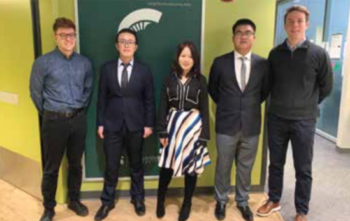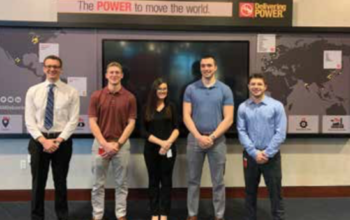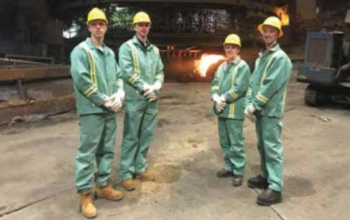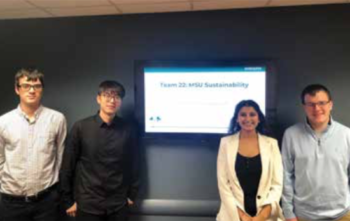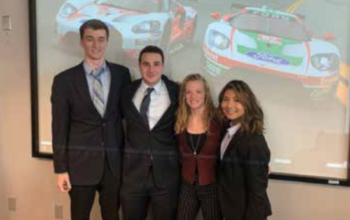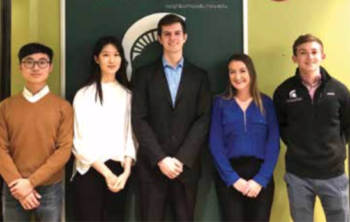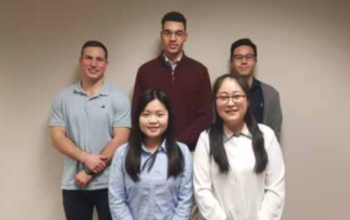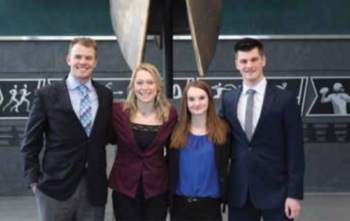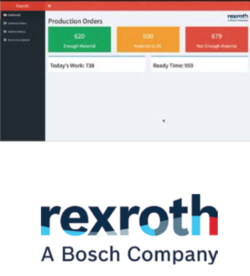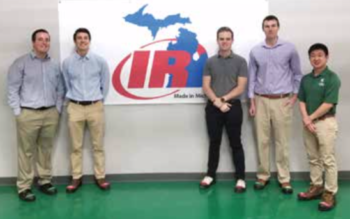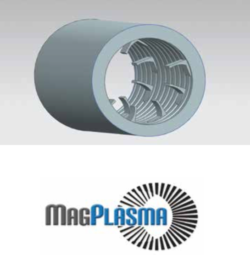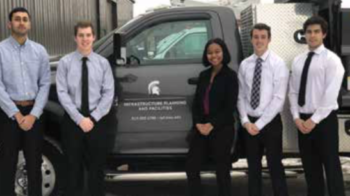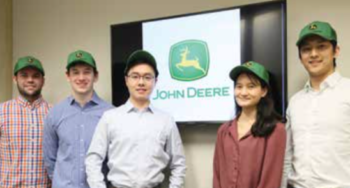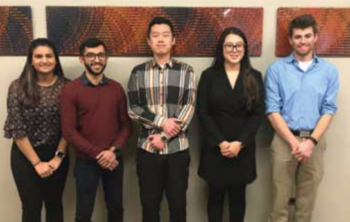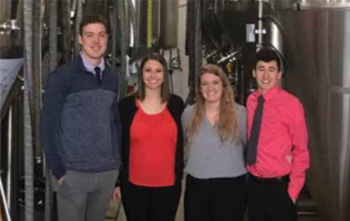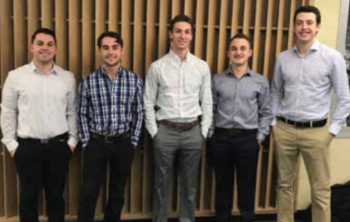For information on becoming a project sponsor, please contact Dr. Laura Genik.
Applied Engineering students participate in Spring Term Design Day. The following were the project sponsors and projects for the Spring of 2019:
ZF Friedrichshafen AG: Competitive Advantage in a Commodity

ZF Friedrichshafen (ZF Group) was founded in 1915 in Friedrichshafen, Germany, which is still the company’s headquarters. ZF is a worldwide automotive manufacturing company present in 40 countries with a global workforce of over 146,000 employees. They are a global automotive leader in driveline, chassis, and safety technology. Their presence can be seen in both original equipment manufacturing and aftermarket automotive products.
Currently, there is concern within ZF purchasing about the relationships with some of their suppliers of a specific commodity. ZF is highly dependent on these suppliers because the commodity is difficult to source and manufacture. This dependency enables suppliers to increase prices annually and ZF does not have insight into the cost drivers behind the increases. The increases are highly profitable for the suppliers and are driven by manufacturing expertise and ownership of proprietary information about the commodity.
Despite facing annual price increases, it is difficult for ZF to resource to new suppliers because the commodity requires high testing costs and involves long lead times to validate new qualified suppliers. For these reasons, ZF’s goal for our project is to develop strategic and sustainable partnerships that will help ZF reduce their dependence on suppliers, provide more insight into the manufacturing process, and increase their competitiveness in the automotive market.
Our team will perform an analysis of ZF’s portfolio of parts that contains the commodity and determine which part family to focus on based on which provides the greatest potential for cost-savings. Once the part family has been selected, a third party will also be selected as a candidate with which ZF can partner. Due to the shelf life of the commodity and other logistical obstacles, the region in which the third party operates will also be a key factor in the selection process.
ZF Friedrichshafen AG: Dynamic Bill of Material for Forecasting

ZF Group, headquartered in Friedrichshafen, Germany, is a global manufacturer in the automotive industry, specializing in driveline and chassis technology. Achieving nearly $48 billion in sales in 2017, and with approximately 230 production facilities in 40 countries, ZF has established itself as one of the largest suppliers in the world. For many reasons, forecasting and supply planning are central to ensure growth and financial success.
Receiving bids from multiple OEMs worldwide each year, it becomes a challenge to organize them and predict how many parts will need to be manufactured. ZF asked our team to create a dynamic forecasting system with user inputs for both customer programs and bill of materials costs for over 300 components.
Our team, composed of Supply Chain Management and Applied Engineering Sciences students, created a framework within Microsoft Excel to quickly and accurately compute the future volumes and cost of OEM bids based on the user inputs. Keeping in mind that bids may close and need to be reflected easily within the framework, an “open” or “closed” feature for bids was implemented. A primary focus for the team was to keep the framework user-friendly in order to ensure a smooth handoff to ZF and ensure its success into the future.
ZF Friedrichshafen AG: Supply Chain Optimization through Advanced Analytics

ZF Friedrichshafen AG, also known as ZF Group, is a worldwide vehicle manufacturing company headquartered in Germany. As a system provider, it provides solutions for future mobility. The ZF Group in North America sector is responsible for axle drives, front and rear systems, automatic passenger car transmissions and active and passive safety systems.
For this project, ZF Group is concerned with cost-saving throughout its transportation network. The goal of our team is to identify cost-saving solutions for the trucks that are being under-utilized. From this, we will create a catalog of tools that will allow consumers, stakeholders, and plant workers to analyze the current transportation network and quickly identify potential opportunities for cost savings, resource allocation, or network optimization.
Our team utilized Tableau in creating an efficient method to analyze the transportation network and display all analyzed data in the dashboard. The primary tool created is a supplier radius map, which was incorporated into the dashboard. This map will help find cost-saving solutions to transport trucks that are not being utilized at full capacity. By selecting a specific supplier, stakeholders will be able to capitalize the usage of their trucks based on load capacity and routes taken. Results will display all other suppliers in a specific distance with weekly volumes and frequencies. The reduction in trucks delivering to the same location without full loads or near their weight capacity will result in large cost savings for ZF Group. Through identifying these inefficiencies, the data and its solutions will be presented in a visual, easy-to-read manner for all stakeholders and consumers of the dashboard.
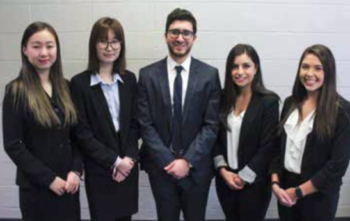
ZF Friedrichshafen AG: Steel Raw Material Specification Consolidation
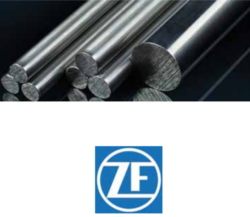
ZF Friedrichshafen AG, is a German-headquartered company with over 200 locations and 146,000 workers in 40 different countries. Founded in 1915, ZF is a global leader in driveline, chassis and safety technology.
Our team has been tasked with finding opportunities to consolidate different steel grades used globally by the company. The complexity and variety of steel raw material requirements used by ZF Friedrichshafen has led to this need for consolidation. After the company’s acquisition of TRW, requirements have become even more extensive and excessive. The main task is to analyze sets of data to determine where steel grades overlap in a variety of metrics and where opportunities for consolidation of supply exist. These consolidation efforts must not compromise the quality of the output; this will be ensured through collaboration with the engineering team at ZF.
The key metrics for quality and safety include stress capability, gauge tolerance, width tolerance and flexibility of steel. Once analysis is done and the team is prepared to suggest future consolidation possibilities, engineers will review potential changes to approve safety and quality, ensuring a consolidation decision is feasible. Further data analysis using different features in Excel will provide determinations of volume and areas for potential changes. Successful consolidation efforts will be necessary and will allow the company to order less grades in larger quantities to take advantage of economies of scale. Even though our team is unlikely to be a part of the realization of this project, we have created a pathway for the sponsor to continue with our work. Upon successful completion of this project, the results will hopefully show savings, both monetary and timing, in the form of cost reductions and simplification in purchasing.
American Axle and Manufacturing Verifying Cost: Analysis of Tariffs
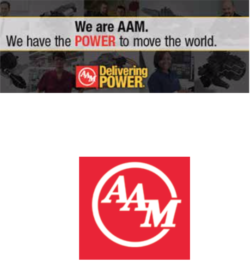
American Axle and Manufacturing is a global Tier-1 manufacturer of automobile driveline and drivetrain components and systems. Headquartered in Detroit, AAM has over 25,000 associates operating at more than 90 facilities in 17 countries around the world.
Our team was asked to help AAM realize tariff savings in their global imports to their plant in Three Rivers, Michigan, by creating a variance reporting tool to show what they are paying to import parts, as well as a “should cost” to help them determine where and how they can save.
Data from the Three Rivers plant’s Plan for Every Part (PFEP) was used to create a Microsoft Excel spreadsheet. The PFEP contains the tariff number for each part and the corresponding duty rate. The duty rate is determined by the numerous and ever- changing Free Trade Agreements that the United States government forms with other nations.
The deliverable requested from American Axle and Manufacturing was an autonomous dashboard to replace their manual review processes to determine the lowest duties possible to pay for their imported parts. AAM requested that the dashboard be created with Microsoft Excel for smoother implementation.
Our team also automated a time-consuming process for American Axle’s Supply Chain employees, freeing up time for them to do other value-added work for the company.
Our team, comprised of Applied Engineering Sciences and Supply Chain Management students, learned how trade agreements affect global businesses as well as received valuable experience working with a prominent automotive supplier.
ArcelorMittal: Safe, Sustainable Steel

ArcelorMittal is the largest steel manufacturer in the world today, capable of producing 114 million tonnes of crude steel per year. During the production of this steel, harmful emissions are released into the atmosphere. As the world continues to move in a greener direction, ArcelorMittal has become more and more conscious of their carbon footprint and are exploring possibilities of how to reduce it.
ArcelorMittal’s goal is to be the world’s safest steel and mining company. Committed to the promise of ‘transforming tomorrow,’ values of sustainability, quality, and leadership guide their mission for the future. Transforming tomorrow is about understanding where society is today and how to have the biggest contribution in the years to come. This strategy is shaped and established by having a competitive edge in industry, but more so by taking society’s expectations of a more circular low carbon economy.
Modern carbon capturing technologies have become more prevalent, providing ArcelorMittal more options to be able to reduce their carbon emissions. ArcelorMittal has been working with another company, LanzaTech. LanzaTech produces a microbe which feeds on carbon monoxide and carbon dioxide molecules in carbon emissions. This creates a liquid byproduct which can then be turned into ethanol fuel or plastics. Our team has conducted research on the inputs and outputs of steel production to understand exactly how their raw materials are being used and what is contained in steel-making process emissions. To help ArcelorMittal move in a more sustainable direction, a spreadsheet analysis tool was created. It can be used to decide whether implementation of LanzaTech’s technology is feasible on all scales. Through this analysis and feasibility study, the team hopes to give ArcelorMittal a more sustainable and environmentally friendly future with the ultimate goal of a completely circular emission process.
MSU Transportation Services: Driving Campus Forward!

MSU Transportation Services drives campus forward– literally. They operate a charter bus service, and they lease vehicles of all kinds to campus departments and colleges to get any job done, while making sure the vehicles are always in optimal condition, with a repair and a fueling station on campus.
Transportation Services has been looking to increase sustainability efforts for several years. They have traditionally done this by purchasing vehicles that still can accomplish whatever job is necessary while being as fuel efficient as possible. They are now looking to continue their sustainability efforts by reducing their fleet size, via a ride-sharing program.
Our team has provided recommendations through a feasibility analysis with extensive data analytics. This analysis shows the path forward to both reduce the internal long-term leases and recoup lost costs through a new delivery method. We gauged the feasibility of using a ride-sharing service, or a shareable vehicle service. Our solution includes an analysis of optimal geographical placement of shareable vehicles. Optimal placement is defined as ensuring highest mobility between departments such that the vehicle is utilized to its full potential. In addition, our recommendations include a cursory analysis of potential labor costs incurred by operating a shared ride service.
With the emissions data from MSU Transportation Services, we were able to propose a plan that will eliminate the highest emission vehicles from the long-term lease program and add the most efficient ones to the new delivery method.
Ford Motor Company: Simplifying the FMVSS Self-Certification Process
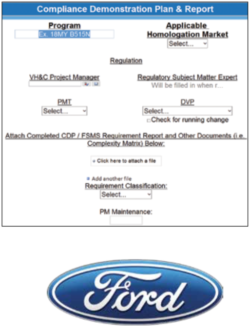
Ford is currently one of the top leaders in the automotive industry. Ranked #2 in the United States and #5 globally, its success has continued to flourish since its establishment in 1903.
Our team has been tasked with working alongside Ford, specifically with its Vehicle Homologation & Compliance section, to create a linear self-certification process system.
In 2018, Ford manufactured over 2.5 million vehicles. Each vehicle has to go through the Federal Motor Vehicle Safety Standards, also known as the FMVSS. This process is to ensure that vehicles are safe to be put on the roads and meet all the safety standards requirements, which are signed-off by engineers and Subject Matter Experts (SMEs).
The objective of our team is to assist Ford with a vehicle’s end-to-end FMVSS process. Our plan is to create a more linear process between Ford’s current programs, InfoPath and Excel, that will reduce the time taken to access and collect files from different engineers and SMEs. We will also focus on removing any of the redundancies Ford has within its current process.
The process will provide an engineering “sign-off” function, a regulated specific proforma and checklist, an auto-generated status report, and an individualized task list for the Vehicle Homologation & Compliance section of Ford. We will also provide a dashboard for Ford’s data, which the company uses to present in its weekly meetings, using Tableau for a cleaner and well-formatted layout.
With the knowledge that InfoPath is being phased out by Microsoft in 2026, our team hopes that the improved process will help the company carry out the FMVSS self-certification process with ease as a short-term plan.
Ford Motor Company: Total Road Load Horsepower (TRLHP) Database Management

Since the 1990 amendments to the Clean Air Act of 1963, the automotive industry has prioritized the increasing stringent requirements of its automobiles’ emissions. Failure to comply with these federal regulations could not only cost the offending company millions in recalls, but also result in hefty fines.
Our project will help Ford Motor Company streamline the effectiveness of pulling reports from its database to support calculations regarding regulation laws that require the fuel economy data of each vehicle. We will be looking at the Total Roadload Horsepower (TRLHP) Database. Working with data provided in Microsoft Excel, our team is delivering process documents and a tool to be integrated into the database by the Global Program Management team to improve data management.
Ford’s current procedure to complete this process takes over an hour per coastdown test, involves redundant and manual data input within Excel, and entails the potential for numerous human errors. This inefficient, costly method is something the Ford team has been seeking to change. There is an opportunity for significant time-saving and risk reduction by automating the data flow and removing the human error and redundancy from the process. The introduction of an automated tool that can coexist with the current process documents and applications without drastically redefining the workflow of the affected stakeholders would be an ideal solution for the Global Program Management team. This tool will collect the necessary data from several other Ford-supplied documents.
The tool will be handed over to the Ford Motor Company upon completion. Our team will not be implementing the tool into the database nor doing any calculations within the documents. Mock data has been utilized in the tool as a representation of the actual coastdown data observed on the test track.
Creative Foam Corporation: Laser Metrology Scanning Equipment Utilization
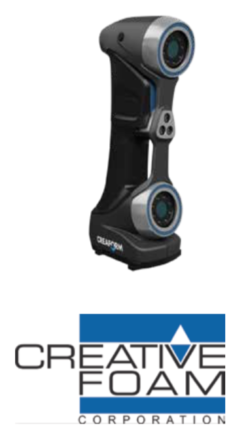
Creative Foam is an engineering company that specializes in die-cut, formed foams and composites.
Our team worked to utilize CreaFoam 3D laser metrology scanning equipment optimally to the current business needs for innovation and development. The first and most important phase of this project is to assess the software currently used by Creative Foam and decide whether this is optimal for the CreaFoam 3D scanning equipment. To accomplish this, the team will study the particulars of the tool to determine whether the software will work well with the tool. If not, we will search for software that works better or propose a potential upgrade to the current software.
The second goal is to prepare a video and/or document with pictures that would help train employees on using the scanner.
The final goal is to use the scanner to improve a given design of a piece that Creative Foam creates and then compare the scan to a given prototype drawing in CAD.
Reaching these three goals will enable Creative Foam to have a better and more efficient way of using the CreaFoam 3D scanning equipment in future projects. If time permits, the team will determine the most efficient way of scanning materials and find the optimal scanning area that minimizes errors when scanning materials. The team will also assess changes that would need to be made for the scan to fit well with a given prototype drawing in CAD.
SnackWerks of Michigan: Automation of Commercial Bakery
Snackwerks of Michigan is located in Battle Creek, Michigan and produces shelf-stable bakery food products and ingredients for branded food companies. Snackwerks’ current operations include contract manufacturing of customer-branded cookies, granola/clusters, snack bites and nutrition bars.
Snackwerks is interested in spot automating within their production cycles, allowing for a smoother and safer working environment. For example, trays of product to be placed in batch ovens are typically hand-loaded and unloaded. Snackwerks currently uses the same production space and ovens for all of their baked products, which means using this space for the spot automation will improve efficiency for many of the products they make.
Implementation of automation systems, such as robots, will help Snackwerks to reduce costs, improve production rate, improve consistency and reduce worker fatigue by replacing manual labor in repetitive operations with mechanical systems. This will further allow Snackwerks to redeploy labor to more rewarding, less monotonous activities in the manufacturing environment.
Roberts Sinto Corporation: Barcode Integration for Inventory Visibility

Roberts Sinto Corporation is a North American group of companies that focuses on providing cost-effective, technologically advanced solutions to a variety of industries. These industries include foundry, sand, bulk material handling, surface treatment and automotive markets. Roberts Sinto specializes in turnkey solutions and machinery for all industrial needs.
Currently, Roberts Sinto uses manual entry for their MRP system, which is inefficient and time-consuming. This manual entry process also makes it more difficult to track inventory as it moves through the warehouse. Conducting cycle counts and looking up locations of parts would be streamlined by implementing a barcode system such as 2D barcode, linear barcode, or Radio Frequency Identification.
The first step is learning how the Roberts Sinto warehouse operates. This leads to the creation of new work instructions for the workers as well as a process flowchart to outline the entire process from receiving an item to the time it ships out. Having a precise instructional document outlining what a worker should be doing along with a flowchart means the workers will always be on the right task.
Following the new task lists, the time studies help to reveal areas where improvements could be made with a barcode system. The barcode system allows for an easy scanning process to update the computer software with the inventory location within the warehousing process. This creates more traceability and eliminates the need to manually type it all into the computer.
MSU MTRAC: Kent County Economic Sensitivity Study
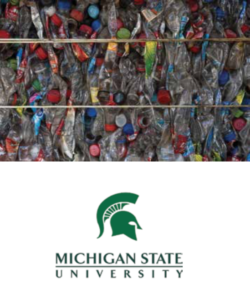
For this project the team will be performing an economic sensitivity analysis of the process of turning plastic waste into fuel. The fuel will be created from plastic waste and the final product is a pelletized fuel substance. This process can produce two types of fuels: 1) untreated fiber-plastic pellets, and 2) thermally treated dechlorefied fiber-plastic pellets (torrefied). This process will be broken down into three main aspects of the waste-to-fuel process which the team will be analyzing.
First, the team will be analyzing the source from which the plastic waste and fiber will be obtained. For this project the team will be specifically looking at landfills and recycling centers within a radius surrounding Kent County.
Next, the team will be identifying potential users of the fuel. The team will be focusing on medium sized power plants, cement factories, farms, and any other small to medium sized operations that require a source of fuel to burn for energy. As a result, transportation costs will then be estimated for the distance from Kent County Sustainability as well as other locations.
Last, with this information, analysis will be performed on the financial feasibility of building a waste-to-pellet fuel plant in the Kent County Sustainable Business Park in comparison to other locations. In doing so, the team will be finding the cost of the entire process of creating pelletized fuel from plastic waste and fiber including, but not limited to, the material, transportation and processing costs involved. The cost of the torrefacted and non- torrefacted processes will then be compared to that of other fuel processes, such as coal and gas. The final proposal will be handed over to Kent County Sustainability Group for their use.
BP: Labor Rate Harmonization
BP is a British oil and gas company based in London, England. It is a vertically integrated organization that deals directly with all operations regarding oil and gas, including hydrocarbon exploration, production, and distribution.
With operations in 70 countries and roughly 74,000 employees, BP ranks amongst the top ten of Fortune 500 companies in the world. Inefficiencies within the supply chains of the oil and gas industry can no longer be masked by strong oil prices, as they were in the past. An efficient supply chain is crucial in the modern business field.
Over half of the hours worked by BP are performed by contractors. This tool was developed to simplify and standardize labor rates of contractors relating to maintenance within the Upstream sector of the Gulf of Mexico region.
This tool takes the internal labor data provided by BP and compares it to the most up-to-date industry average wages for each job category. Using regression analysis methods, it extrapolates a simplified rate structure for each specific subcategory of labor. This will allow BP to have a standardized and transparent view of their rates, thus reducing costs related to contracting and hiring, as well as simplifying the labor sourcing process.
The implementation of this tool will greatly reduce the time required to analyze and select contracting options for maintenance labor by minimizing the complexity of the process. This time reduction combined with a lower assigned labor rate due to the standardization of the tool, will result in a monetary savings for BP.
BP: Analyzing Incentivization in Construction Contracts
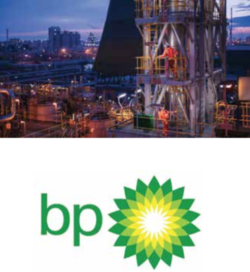
BP is known around the world as an industry leader in the oil and gas industry. In order to gain and maintain their standing in the industry, the development of infrastructure that processes and transforms the materials our world runs on is imperative. In turn, a significant arm of BP’s global operations lies in the construction industry.
BP invests significant financial resources towards construction projects around the world on a yearly basis. In order to get the most return value on each of these projects, it is in their best interest to determine the effects of the incentives they use in the contracts they award to their suppliers. Different aspects of the projects they undertake can be affected by the different incentives used in the contracts. The incentives used can have an effect on how well the supplier does in delivering what is outlined in the contract.
As a result, one of the project’s main goals is to develop a tool or methodology that will help BP determine the effectiveness of incentivization on future construction projects. This is done using a weighted analysis of different factors that go into the contracts themselves in coordination with multiple regression analysis. These factors include completion time, management, and cost. The developed framework will take into account supplier-risk analysis to help determine the best route forward regarding individual construction projects.
Major themes driving the project include data analysis, supplier risk analysis, and analytical framework methodologies. Data analysis is limited to historical industry data, specific to the oil and construction industries.
In turn, this tool will be utilized in the selection of suppliers for construction contracts around the world and help predict the effectiveness of incentivization in the awarding of contracts. The tool is developed in Excel and incorporates multiple regression analysis and includes aspects of the Analytical Hierarchy Process.
Bosch Rexroth: Implementation of Production Dashboard
Founded more than 200 years ago, Bosch Rexroth has been one of the leading specialists in the field of drive and control technologies, employing over 33,100 people worldwide and reaching approximately $6.25 billion in sales yearly. With Bosch Rexroth’s passion for becoming an Industry 4.0 leader, Rexroth has tasked our team with devising a production dashboard to create material visibility for the Industrial Controls Multi-Product line. For the purpose of this project, we focused on one of Rexroth’s Industrial Hydraulics production plants located in Bethlehem, Pennsylvania.
Our team designed a production dashboard that streamlines production orders and their status by providing a convenient and efficient way to analyze, summarize, and display data from the production orders and material inventory at a single glance. This includes various visual representations of the data that provide insight into inefficiencies within the production line. The overall goal of the dashboard is to eliminate production deviations due to lack of material visibility.
The dashboard provides high-level metrics so that the user can determine the status of production for any given day. It can also assist the planners and pickers in visualizing the status of materials on-hand and materials still needed for production orders. An embedded algorithm is incorporated that recommends the best sequence of production based on material needs, date, and priority. This provides clarity so that the user can make better production decisions, ultimately increasing work efficiency.
The dashboard is delivered in the form of a web-based application utilizing Shiny, RStudio, and Python, that includes a homepage and three pages with the following content: Schedule Status, Material Status and Recommendations. The final automated solution is designed in such a way that additional features can be built in later.
Gerdau: Long Lead-Time Product Optimization
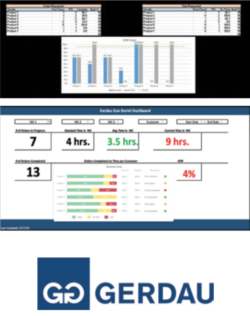
Gerdau is a leading company in the production of long steel in the Americas. With an installed capacity of 26 million metric tons of steel annually, Gerdau is among the major worldwide suppliers of special long steel for the automotive industry but also controls a large share of the Gun Barrel Specialty Steel market. Although gun barrel only accounts for approximately 1% of total shipments annually, due to its high visibility and Gerdau’s unique casting process, it currently serves as an untapped market for potential profit.
In any special bar steel market with significant demand, there are a multitude of constraints that can impact delivery performance. The main objective of this project was to find the location of those constraints and bottlenecks in gun barrel production. In order to complete this objective, three deliverables were agreed upon between our team and the company: a process map, a production scorecard, and a monitoring dashboard.
A swim lane diagram was used to map the process flow for the highest volume products. A scorecard was designed in Microsoft Excel to track the production progress and create a relative comparison between the current On-Time In Full (OTIF) percentage and the goal OTIF percentage. Tableau was used to create a dashboard in order to monitor delivery metrics for specific customers and time ranges. The ARENA Simulation tool was also utilized as it allowed our team to take the process map and run trial simulations in order to showcase where potential bottlenecks could be occurring. The data were restricted to solely focus on pre-recorded data from the melt shop to testing and the top 30% of volume. Cost analysis, products other than gun barrel, and the causes of delay were out of the scope of the project.
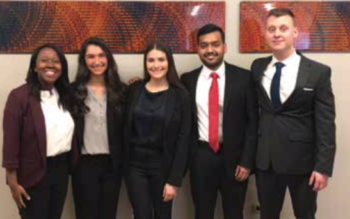
Ingersoll Rand: Predict Regional Peak Seasons With Online Weather Forecast Data
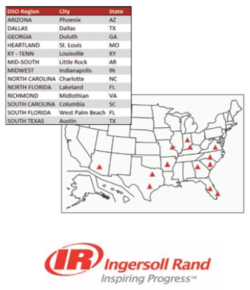
Ingersoll Rand is a global industrial manufacturing company founded in 1905. Its Global Headquarters is located in Dublin, Ireland. The company is built on its Irish-American roots, and contains several divisions including: Club Car, Ingersoll Rand (Industrial Equipment), ThermoKing, and Trane.
Our team was tasked to support Trane HVAC product lines by effectively predicting the start and end of peak seasons for 5 product families in 13 regions around the United States. This will minimize service drops, by gaining customer appreciation and increased sales around the US. The project focuses on the top selling, and high velocity items of air handlers, coils, furnaces, package units, and splits.
Using previous years’ sales data from each region, it was determined there was a correlation between sales and temperature. By relating the increase in temperature to the increase in sales for the given units, the region’s peak season lies within it. It is commonly known when it is hot outside, people are likely to turn on their A/C units. This is when customers may realize their units are not functioning properly, resulting in a high influx of sales. If the peak season can be predicted prior to when this occurs, planners will then be able to ensure that enough inventory is shipped to the Dealer Sellers Offices (DSOs) to minimize loss of sales.
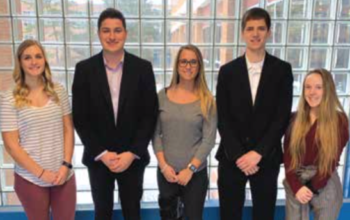
Ingersoll Rand: Design of a New Plant Layout
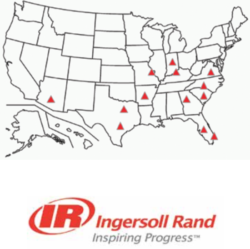
Ingersoll Rand is a worldwide industrial manufacturing company that produces a wide variety of products. Their plant in Madison Heights, Michigan manufactures jib cranes and Zimmerman rails.
Our team was tasked to support the Zimmerman Rails manufacturing plant. The goals of the project are to reduce the time it takes to manufacture each beam from start to finish by better utilizing floor space in the plant, enhance safety protocols to mitigate accidents, create a process workflow and organize incoming and outgoing inventory.
The raw materials for Zimmerman rails and jib cranes are steel and aluminum beams ranging from 14 to 30 feet in length. The steel beams are imported from India and the aluminum beams are ordered domestically. The international orders have long lead times of about three months and, because of this, the shipments are very large. The shipments generally contain enough inventory for about six months of orders. Due to the length and weight of the beams, unorganized storage space, and an imbalance of worker responsibility, the manufacturing and receiving processes are not at optimal efficiency.
A new plant layout will also be implemented to ensure efficient storage of the beams. Overall, the workflow process will be enhanced, allowing Ingersoll Rand to produce their product more efficiently.
MagPlasma: Plasma Activated BioChar Prototype
MagPlasma was started in order to apply the latest advances in technology to commercial markets.
Our team was tasked with the improvement and design of a biochar filter component to be used for water treatment. Once the biochar is created, it is treated with plasma to make the surface of the biochar more porous. Activation also increases the surface area of the biochar, allowing for water to flow through the material in order to be treated. Additionally, the porousness of the activated biochar allows for the filtration of extremely small substances that otherwise could not be filtered using traditional methods.
The advantage of activated biochar is that it can reduce the energy needed for the water desalination process. The biochar can be activated in minutes by continuously running the material through the plasma. In order to do this, a rotating filter is used.
The filter component is a hollow cylinder threaded along the inside. The threads are outfitted with L-shaped extrusions spiraling throughout. The extrusions scoop biochar and drop it through the plasma as the cylinder rotates. The material is moved through the entire cylinder in under 10 minutes using a motor that rotates the apparatus. By threading the inside and staggering the extrusions, biochar can move from one end to the other through the rotation alone. The component will be made of a stainless steel or aluminum.
The moving system will allow larger amounts of biochar to be activated without stop. The part is simple enough that it can be scaled up easily, making larger industrial applications feasible in the future.
MSU IPF: Materials & Logistics Department: Improvement of Recycling Processes
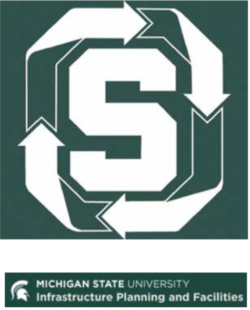
The Materials & Logistics Department within Michigan State University’s Infrastructure & Planning Facilities is responsible for procuring, stocking, and delivering tools, materials, and equipment for direct support of Maintenance Services. They are continually working to improve their sustainability efforts throughout campus and at their facility.
This project is focused on evaluating the different recycling processes that are currently in place throughout the department. The team is responsible for identifying potential issues in the cardboard, aerosol can, propane tank, battery, mixed paper and plastic recycling processes. Our team researched sustainable ways of reducing waste and improving the flow of materials throughout the department. Suggestions for improvements and identification of potential issues on the several different recycling processes are given to Michigan State’s IPF management. This will increase the amount of materials recycled from the facility and help improve their sustainability efforts based on the results obtained from this project.
MSU IPF: Materials & Logistics Department: IPF Fleet Optimization
Michigan State Infrastructure Planning and Facilities (IPF) plans, builds and maintains the physical environment for the university. This includes managing over 179 vehicles used by 19 trades such as HVAC, plumbing, and electrical that maintain MSU’s facilities. Due to the growth of the university and technological advancement, there has been an increased demand for IPF vehicles and requests for additional vehicles to be added to the fleet. However, IPF’s utilization data does not support the additional purchases, and over the last three years IPF’s fleet efficiency has decreased as a result of the challenging environment.
The goal of the project is to improve IPF’s fleet efficiency, reducing carbon footprint and minimizing costs. In order to do so, the team analyzed fleet data metrics such as idle time, utilization rate, geofencing, fuel economy, and carbon emissions. Using these metrics along with interviews conducted with department supervisors to conceptualize the data, each department was ranked anonymously and given corresponding efficiency scores. Our team used the optimization technique of data envelopment analysis to generate efficiency scores based on 12-month historical data.
Leveraging this data, IPF was provided a report summarizing the current state of fleet operations, highlighting potential areas for improvement, and providing recommendations corresponding to each metric analyzed. The report includes statistical and social analysis, standard operating procedures, and tools to assist IPF in reaching sustainability goals.
MSU Business Construction Management: Market Study for Lumber Salvaging Device

Michigan is home to approximately 225,000 abandoned homes and thousands of abandoned commercial buildings. Within these buildings, there are approximately 903,784,000 board feet of salvageable lumber. Nationally, there are 5.43 million abandoned homes. In the US, there are over 23 billion board feet of salvageable lumber, which is equivalent to over 32 million trees. Often, the cost to prepare and reuse salvageable lumber is greater than its market value. This leads to approximately 14.5 million tons of wood going into landfills each year, which is more than the amount of timber harvested from national forests each year. With rising dumping fees, deforestation and pressure for future sustainability, this is a major opportunity to reduce landfill waste.
Our team is seeking to develop a time- and cost-efficient solution to salvaging lumber during deconstruction by creating a device that could expedite the process. The project focuses on creating a robust market study for the economic viability of such a device. The goal of the project is to form a market study that identifies improvement opportunities within the process of reclaiming wood in order to gain a deep understanding of the market potential and what features the proposed device should be able to accomplish. A key objective in this process includes researching alternative non-destructive processes for reclaiming wood. Another objective is to investigate current and future economic, legal and political variables such as the cost of cutting down virgin lumber, landfill price fluctuations, and trade tariffs. Upon completion of these objectives, the team will be able to delineate where and when this device will be most effective.

John Deere: Achieving Excellence Program
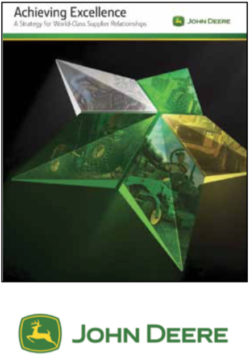
John Deere is a Fortune 500 company that manufactures agricultural, construction, and forestry machinery, as well as other products. With such a vast range of products, John Deere relies heavily on their suppliers’ performance. To ensure the necessary parts for each product are on time and at the right quality, John Deere utilizes their supplier performance program known as Achieving Excellence (AE). AE has been in place for over 20 years and has been a critical tool for building strong supplier relationships. This program allows John Deere to work with their suppliers to improve their performance in key categories such as delivery and quality. This project focuses on the delivery component of AE, which has the greatest opportunity for improvement.
Our team performed an assessment of the current John Deere AE program. Working with the AE team, we focused on measuring performance of suppliers through the delivery segment of the AE program. Our team analyzed past data and produced a proposal to accurately rank suppliers based on specific chosen metrics. These metrics were modeled through a point rating system. The proposal allows suppliers to strive for continuous improvement which will enable John Deere to work with the best suppliers available.
For the first deliverable we utilized software, such as Microsoft Excel and R, to perform analysis of the data. For this project, our team focused on John Deere’s global suppliers that supply the direct materials for all product lines. Using software, we built a quartile system for the delivery parts per million of these suppliers. Delivery is historically a subjective ranking system, so using more data can make this process objective. This will give suppliers more feedback to see how they compare to their peers. This deliverable will be presented in Tableau.
The second deliverable was a stretch goal that includes doing an impact assessment for deliveries by these same domestic suppliers. Our team looked at deliveries by these suppliers and assessed how an early or late delivery affects the manufacturing line and ultimately the final product.
John Deere relies heavily on strong relationships with the best suppliers in the industry. Upon completion, our goal is to help improve the already successful AE program and create better feedback between John Deere and its suppliers.
John Deere: Tillage Bundling Optimization

John Deere is an American corporation that has made an impact on revolutionizing agriculture with its technology in farming equipment. One of the main product lines within its agriculture division is tillage machinery. Tillage is the preparation of soil by digging, stirring, and overturning, with an aim to ready the soil for the growth of crops.
Although John Deere is a giant within the agricultural world, there is always competition from rival products. Both John Deere and their competitors send pieces of their products to a dealership. The dealership is then responsible for finishing the assembly of both John Deere’s and the competitor’s products at the same location.
Final assembly of John Deere tillage equipment is a top inconvenience for dealerships with John Deere products. Dealerships have stated that the total assembly time for tillage equipment is much higher than the projected time provided by the factories and the competitors’ average assembly time. When the final assembly takes longer than expected, several issues and risks may occur. A few of these risks include the dealers’ profit margin may decrease, dealer resources may be in conflict, and customer delivery dates may be missed.
John Deere asked our team to analyze the current processes and create a solution that streamlines the assembly process. The solution included optimizing the pre-delivery instructions as well as improving the bundling of materials. In addition, we provided a value stream map to John Deere that focused on the cost of bundling. Lastly, they led a leadership workshop that illustrated the benefits of switching from the current process to the proposed solution. Overall, the potential benefits of the proposed solutions are reducing waste, cost, and most importantly, strengthening relationships with their dealerships.
NASA/Arizona State University: NASA Psyche Mission: Send Your Name to Psyche

NASA is launching a global campaign called “Send Your Name to Psyche” to engage the public in their mission to explore an all-metal asteroid called Psyche. NASA, in partnership with Arizona State University (ASU), aims to excite the public throughout the Psyche mission timeline, while ensuring that all mission phases are carried out successfully. The “Send Your Name to Psyche” campaign is important for the mission as a means involving the public. The campaign allows the public to register their name for implementation onto a microchip being sent with the spacecraft. Hence, the campaign is titled “Send Your Name.” There are numerous capstone teams from different universities involved in a project of this size and scope, which makes our team’s final product part of a larger whole.
Our team has focused on developing a tangible, modeled concept of the frontend user experience for the campaign website, from the point of user name submission to the point of mission completion. We have administered surveys to collect data on preferences regarding website design and security options from the general public. Data collected has been analyzed using statistical tools and presented to the team’s sponsor as consideration for further campaign development. The final deliverable is a recommended outline of the user interface based on the quantitative data collected. In conjunction with the outline, our team is providing a high-level guide that will address potential threats and technical issues that could arise on the backend of the website. With our recommendations, NASA and ASU, along with other capstone projects, can continue to advance and finalize the phases of the “Send Your Name to Psyche” campaign.
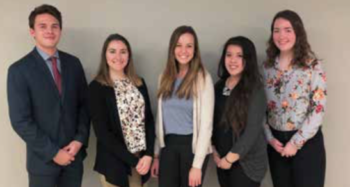
Asahi Kasei Plastics North America: Predictive Modeling of Cashflow

Asahi Kasei Plastics North America, headquartered in Fowlerville, Michigan, is a chemical company that manufactures plastic compounds. It produces plastic for customers in a variety of industries including, but not limited to, automotive, electrical, and housing. In manufacturing plastic, there are various raw materials that go into each type of plastic. Many of these raw materials are in markets that are constantly changing and can be very unpredictable. Operating in these fluctuating markets makes it difficult to predict future net income. Asahi Kasei is working to create a predictive model to anticipate its cashflow impact based on these changing feedstock markets. Because Asahi has contracts with its raw material suppliers and customers based on market indices, being able to understand how these indices have been changing will help anticipate what will happen in the months to come. Not having this visibility can impact the company’s ability to hit cash targets and, in turn, reduce shareholder value.
Asahi Kasei Plastics desires to have a model in place that will visually show the impact of these changing markets on its cost of goods sold, gross profit, and net income. Building such a model requires a deep dive into Asahi’s raw material and finished material purchase agreements. Being able to see the changing market indices from the past month, quarter, year, etc. will help strategically plan contract negotiations and determine what factors might be causing these upward or downward trends in the market and Asahi’s net income.
Ellison Brewery + Spirits: Sustainable and Efficient Brewery
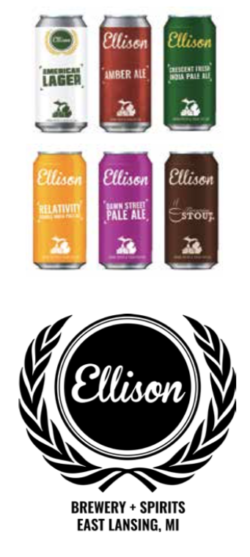
Ellison Brewery + Spirits is a microbrewery based in East Lansing, Michigan. Sustainability and efficiency are two target areas for improvement at Ellison. The recycling and reuse of spent grain present an opportunity for such value addition. Spent grain is a type of waste resulting from the beer brewing process after all the desired flavor and ingredients have been harvested from fresh grain. Two opportunities that arise from reusing spent grain lie in converting spent grain into a material similar to recycled cardboard and the creation of 100% edible feed for livestock.
The first option entails milling and pressing the spent grain into a usable cardboard-type material in the form of plates, multi-pack cases and even straws. This would not only be sustainable by recycling the leftover waste after the brewing process, but it would also provide tangible objects that Ellison could potentially use in their day-to-day operations. With the help of the School of Packaging at MSU, our team will be able to utilize lab space and equipment to perform trials and create cardboard out of the spent grain on a small scale.
Another option for Ellison to reuse the spent grain is turning it into an edible product for livestock. The treatment of spent grain would turn it into readily available feed which presents an opportunity to generate revenue by selling the repurposed waste. The treated spent grain could not only be used for livestock, but it could also be used for making bread, dog treats and more.
The main goal of our team is to provide a complete solution that Ellison Brewery + Spirits would be able to implement into their daily operations.
BorgWarner: Variable Cam Timing Green Machining
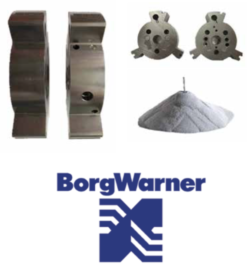
BorgWarner Inc. is a global leader in clean and efficient technology solutions for combustion, hybrid, and electric vehicles.
Our team was tasked with analyzing the current processes employed in the production of BorgWarner’s powder metal rotors used in their variable cam timing applications. Our focus was to develop a plan to improve the processes used by reducing cost and cycle time through the implementation of green machining.
Green machining is an alternative method of manufacturing powder metal. It involves post-machining the powder metal component while it is in the ‘green state.’ Machining parts prior to sintering can greatly extend tool life, which can have great cost benefits as well as reduce cycle time.
BorgWarner provided our team with all of the necessary technical information to complete this project. We were provided with rotors, rotor blanks, ‘green state blanks,’ CAD models, engineering prints, and a cost model. Along with the technical tools to complete the project, we maintained a constant open line of communication with some field experts internally in BorgWarner.
Using the resources available, we were to develop a plan through research, analysis, and innovation. The plan would detail specific actions that would improve BorgWarner’s current rotor manufacturing method. These suggested activities were executed with the overall goal in mind, which was to find a low-cost approach to machining that improves market competitiveness and helps expand BorgWarner’s global supply footprint.



